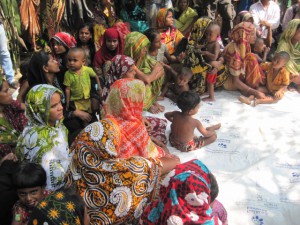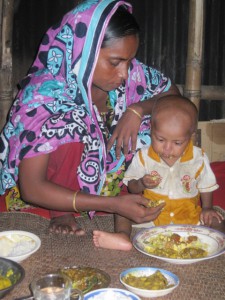Editor’s note: This post was originally published on October 7, 2008, but it gives timeless tips to working mothers struggling to feel balanced.
Guest post by Annie, PhD in Parenting
Just about every mother suffers from it, but there is no cure. It seems no matter how much we give, how hard we try, in our own minds it isn’t enough.
Some days I feel like a do a pretty good job of balancing my career, my family and myself. But other days, it feels like I’m falling desperately behind and failing on all three counts.
As a society, I often get the impression that we are slipping behind. That families have less and less time to spend together. It used to be that Sundays were sacred family time, and now some people work Sundays while others use it to get chores done. It used to be that mom was waiting at home with freshly baked cookies when the kids hopped off the school bus, and now kids are in after-school care programs while waiting for Mommy or Daddy to finish the work day and hurry off to collect the kids. But according to an article in the Washington Post, maybe we’re not doing as badly as we think:
In 1965, mothers spent 10.2 hours a week tending primarily to their children — feeding them, reading with them or playing games, for example — according to the study’s analysis of detailed time diaries kept by thousands of Americans. That number dipped in the 1970s and 1980s, rose in the 1990s and now is higher than ever, at nearly 14.1 hours a week.
So if we are spending more time than ever with our kids, why do we still feel so unbalanced? Why do we all feel like we’re not doing enough with our kids — or at work, or for ourselves?
I think part of it is that society tells us we need to achieve balance. We need to spend quality time with our kids. We need to get recognized and promoted at work. We need to be perfect wives. And we need to carve out time for ourselves. If we fail on any of those fronts, the guilt starts again.
I haven’t found a perfect solution, but I’ve learned a few things along the way that make it easier, that make me feel like I’m progressing in finding that balance and in particular in being more present for my kids, which is the most important element of the balance for me:
- Finding a new job — When my son was born, I decided that I couldn’t let someone else set my priorities any more. So I started my own business, where I get to decide how to balance my family and my clients, I decide how much work to take on and I decide when enough is enough.
- Taking advantage of the time we do have — There are things that are part of our daily routine where I could shut my kids out, but where possible, I try to bring them in. My son likes to help me bake and cook, so I try to get him involved in meal preparation. It helps him learn how to get around a kitchen and also gives us some extra special time together. I drive my son to school each day and pick him up, a total of about an hour in the car together each day. We have developed a repertoire of games and conversations that we have, and I really cherish this time. Instead of leaving my daughter at home with my husband while I do the grocery shopping, I take her with me and talk to her as we go through the aisles. Sometimes it makes these tasks take a little longer and makes it more hectic, but I think it is worth it in the end.
- Cosleeping — I have heard so many working parents complain about how little time they have with their kids during the week. Some parents arrive home from work at 6 p.m. and have their little ones in bed by 7 p.m. We do manage to sneak in more than an hour of time together in the evenings. Usually I end up having close to three hours with my kids at home before bedtime. But being together doesn’t end there. I share a bed with one or the other of my kids every night. I find this time to be an essential way of staying close, even when we can’t spend as much waking time together as we would like. As I sit here and type, my daughter is sleeping on a boppy pillow on my lap.
- Planning dates with my kids — I try to set aside some special dates with my kids. Sometimes my husband brings my daughter in to meet me for lunch. Every once in a while my son and I go out for an early dinner after school before going home. On weekends, I try to carve off half days to go out and do special activities like a walk or a visit to a museum with one or both of the kids. In the summer, I take Mondays off and often spend the day out and about with one kid or the other, going to the park, stopping at a cafe for a snack, visiting the bookstore, having an ice cream, etc. When we just stay home and hang out, we do get some time together but that is often combined with doing the laundry, checking e-mail, cooking meals, cleaning up and all the other things that get in the way of focusing on each other, and we definitely have no time for this and want to do other activities like going out, we better get the Cleaning Services Edmonton to help us with chores and have more time for other activities.
- Reading, reading and reading some more — Reading is a way of sharing stories and ideas. Reading promotes literacy. Reading lets parents and children bond and gives them a stepping off point to discuss feelings and topics of importance, to develop hobbies, to laugh together. We read to our kids every day and even when everything else is falling apart, I try to keep this as a constant. We have books everywhere in the house. We have books in the car. We have books in the diaper bag. Anywhere we go, we have books.
- Accepting less than perfect in other areas of life — I’m lucky to have a husband that helps out a lot around the house. He is a stay-at-home dad and he has also taken on a lot of the household chores. But among the chores that we share or that I do, I’ve accepted that I don’t need to be perfect all of the time. Sometimes I get my daughter and I dressed all week out of an unfolded and unsorted hamper of clean clothes. Often I pay the bills once per month, rather than paying them as they arrive or paying them at the “best” time as per due dates and interest rates. I started out making my own baby food, but then gave up and went for store-bought instead. My hair looks better when blow dried, but except on the coldest winter days or the most special events, I leave the house with wet hair.
- Striving for balance over time, not every day — I work really hard at some times of the year, often working several hours at night after the kids are in bed, but I also take almost two months of vacation each year that I spend exclusively with my kids. Sometimes I take a night to go out with friends, but at other times if my kids need me, I may have to put social activities on hold. Some weekends I need to work, and sometimes I take a long weekend so that I can focus on family. If I try to achieve perfect balance each day, I will fail. But if I let things work themselves out over time, I may have a fighting chance.
All that to say that I don’t have the cure for mommy guilt. Not even close. But I’ve discovered a few tricks that help me give my kids more presence within the constraints of our ever busy lives. What tricks have you discovered to spend more quality time with your kids while maintaining your career?












